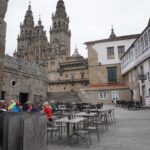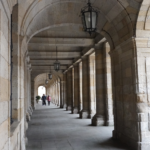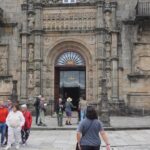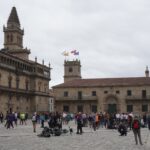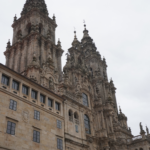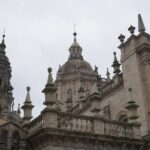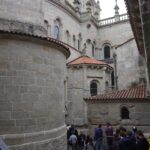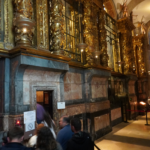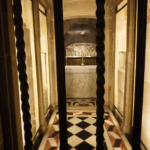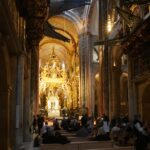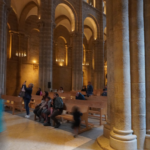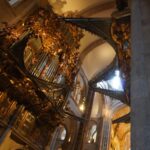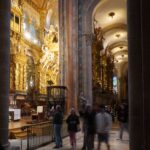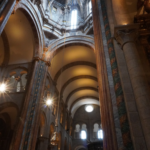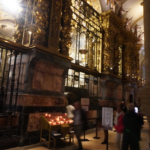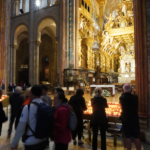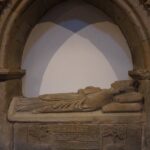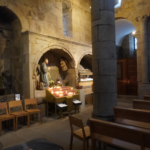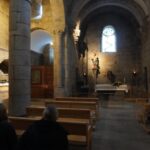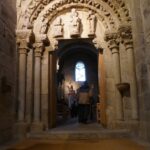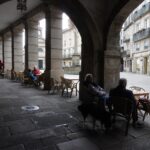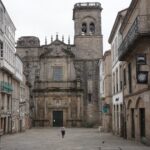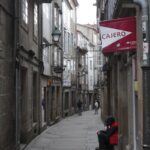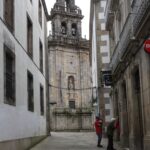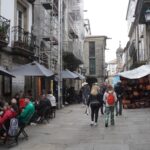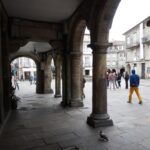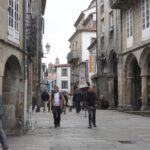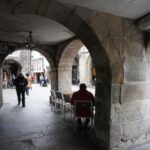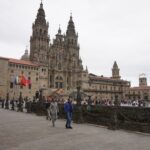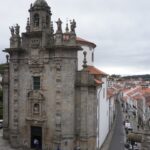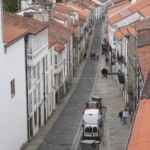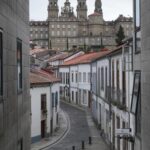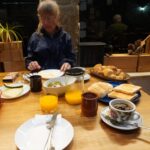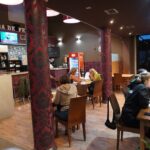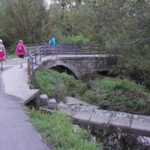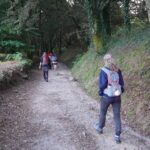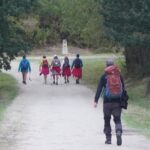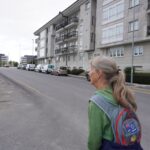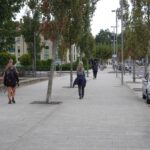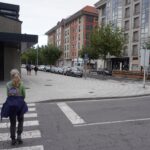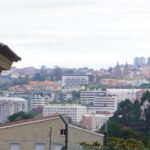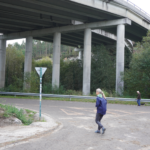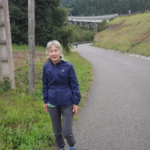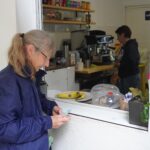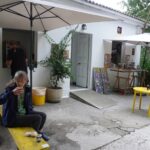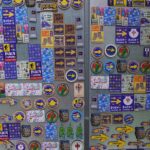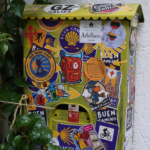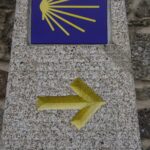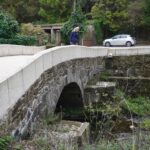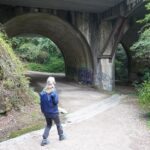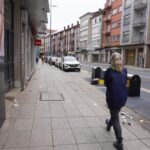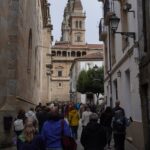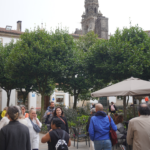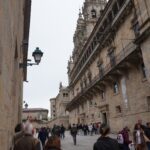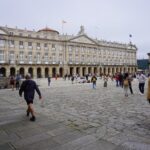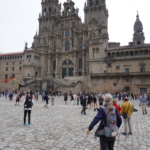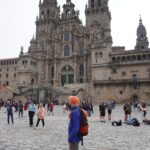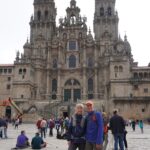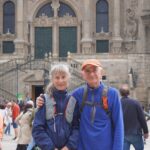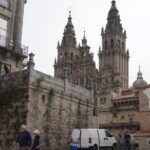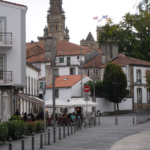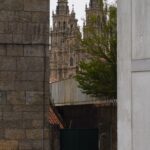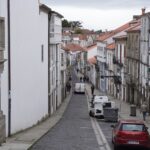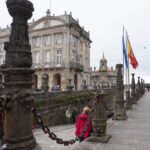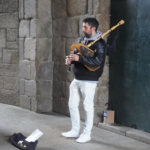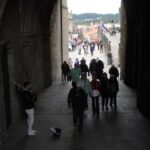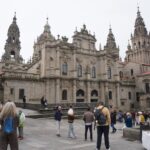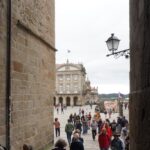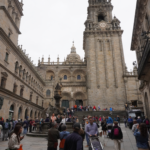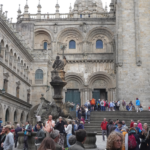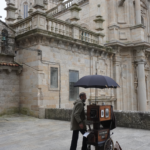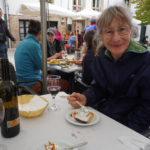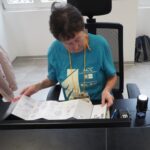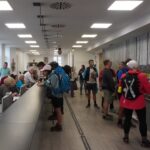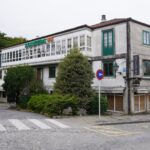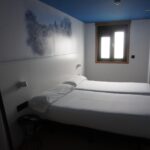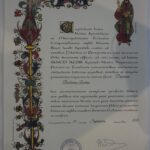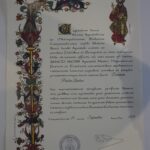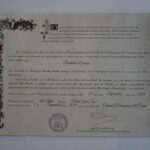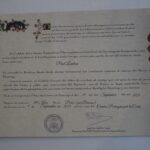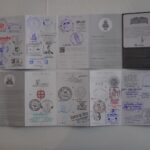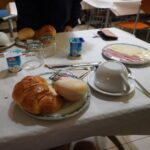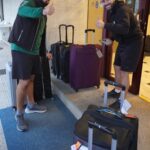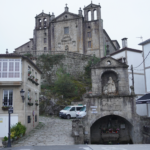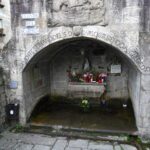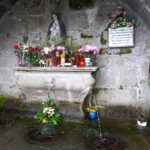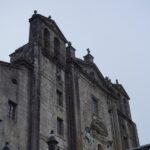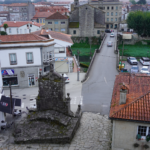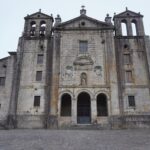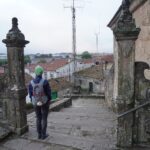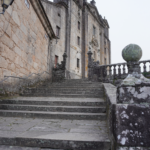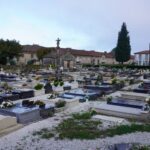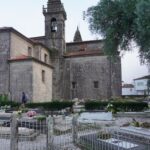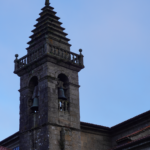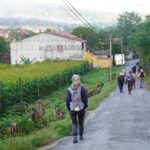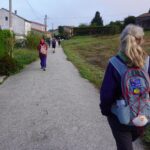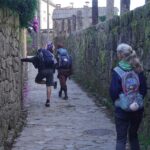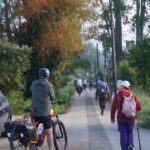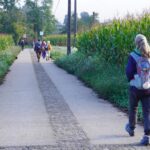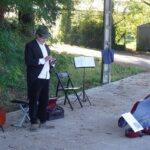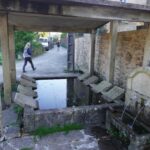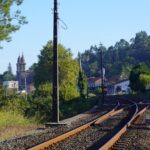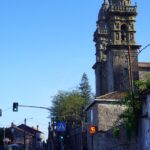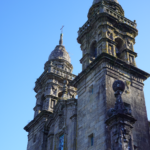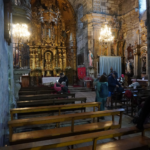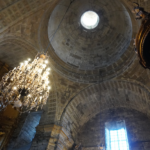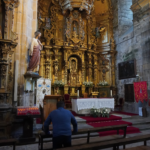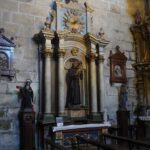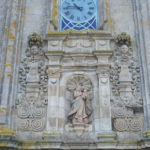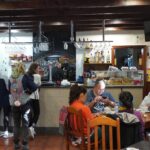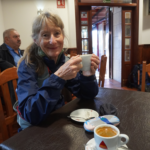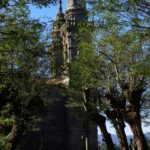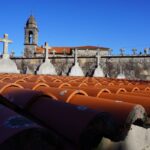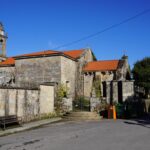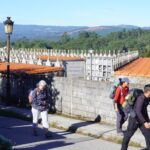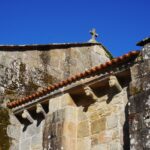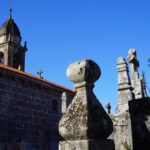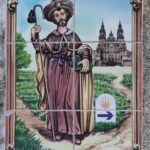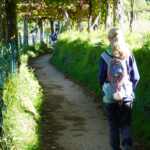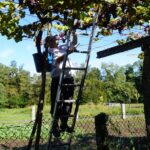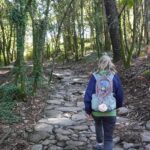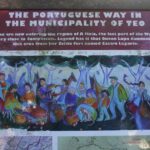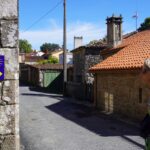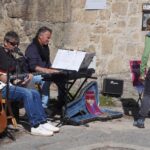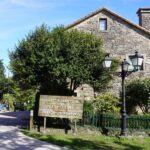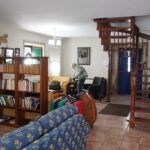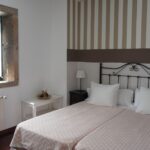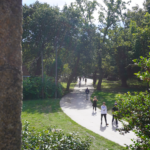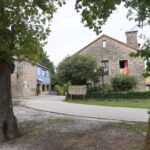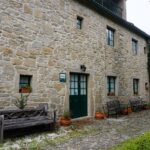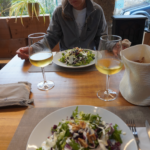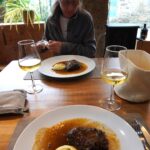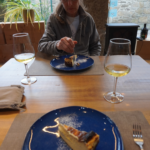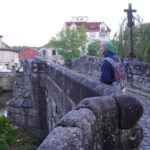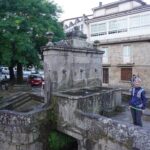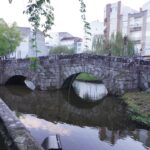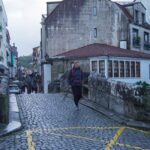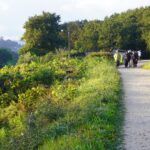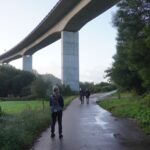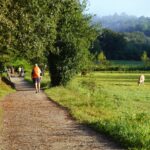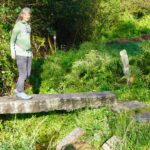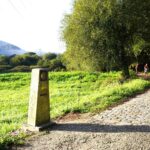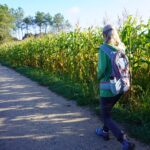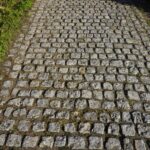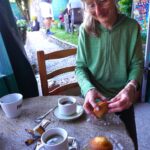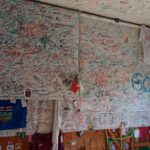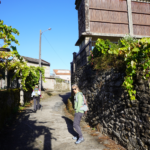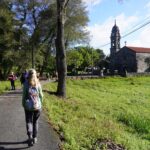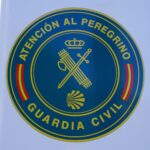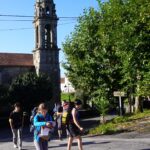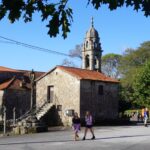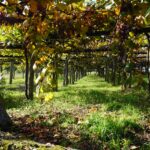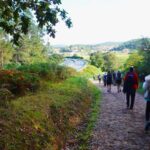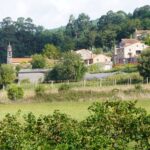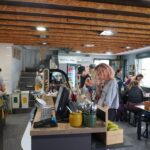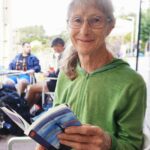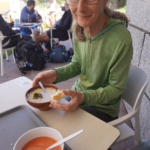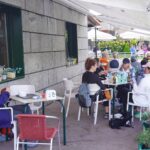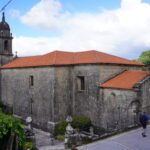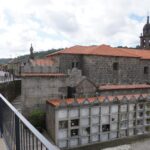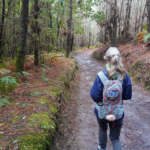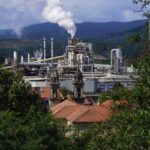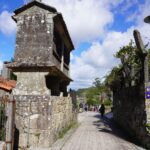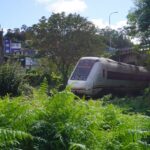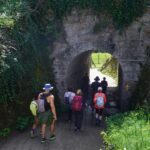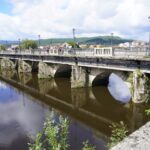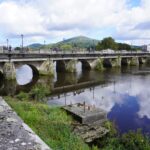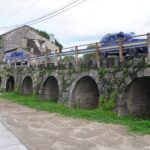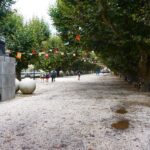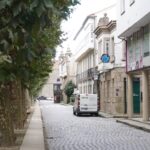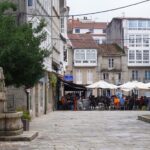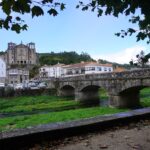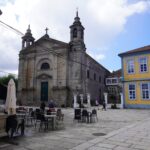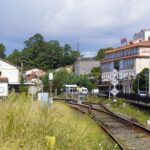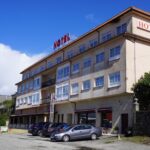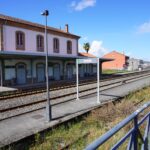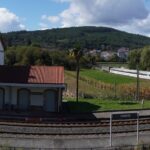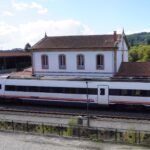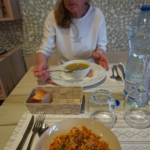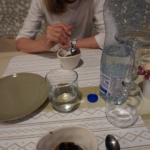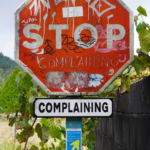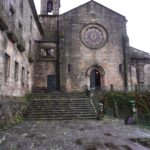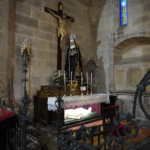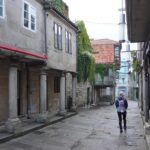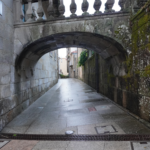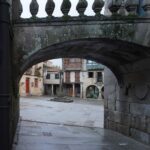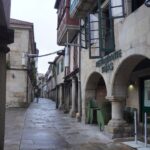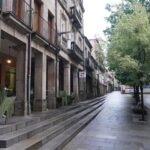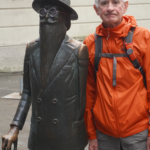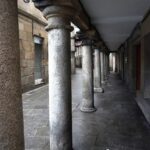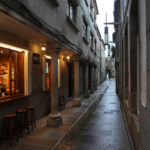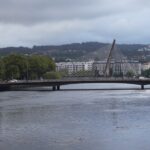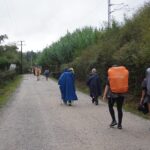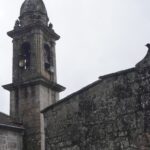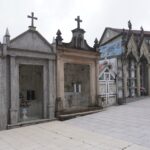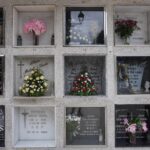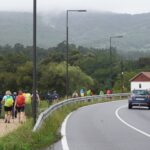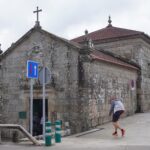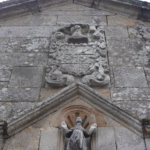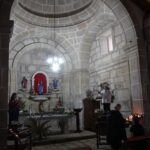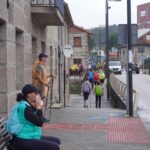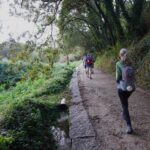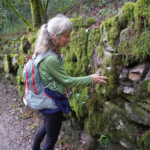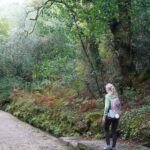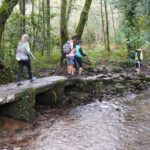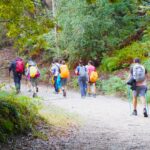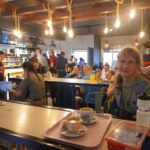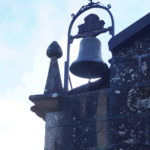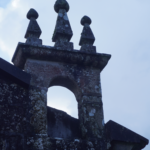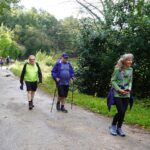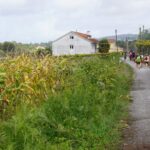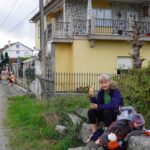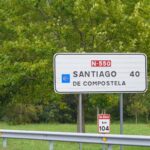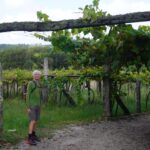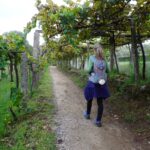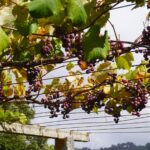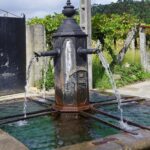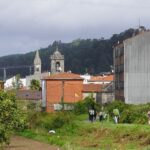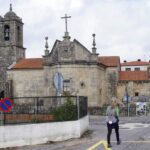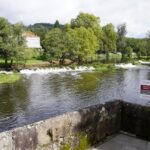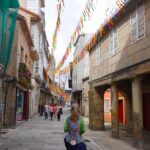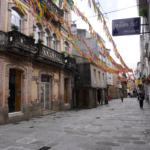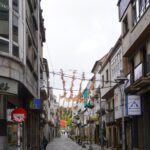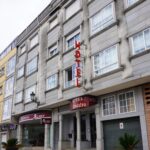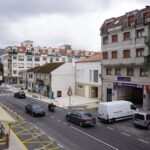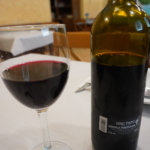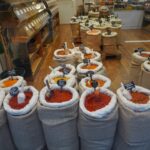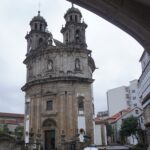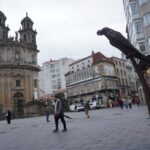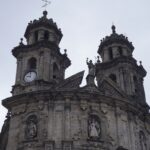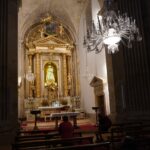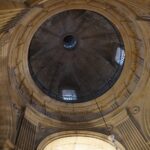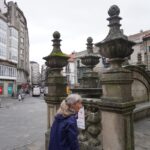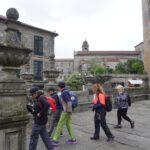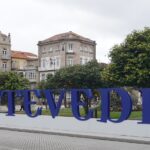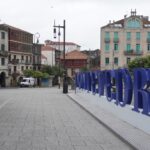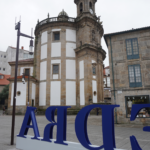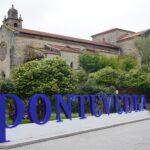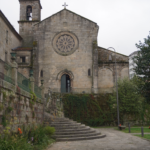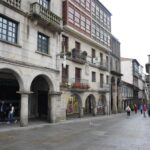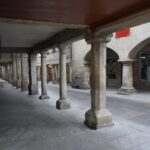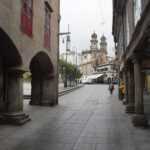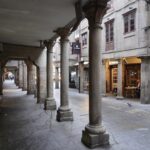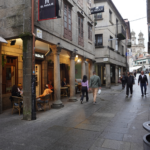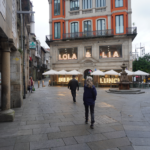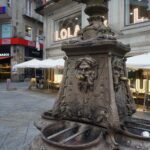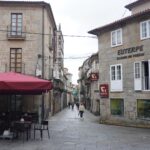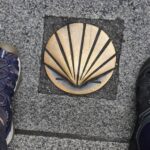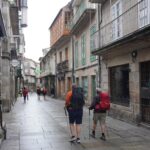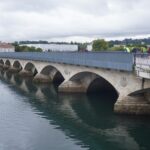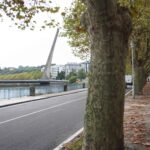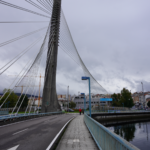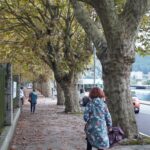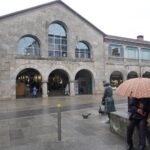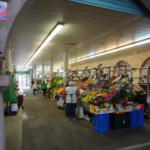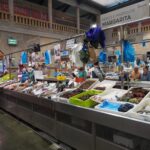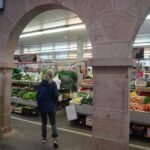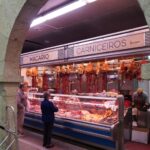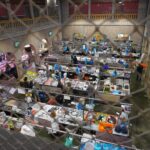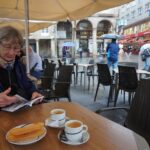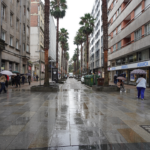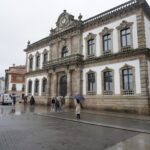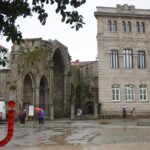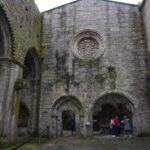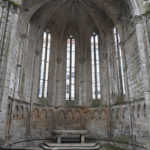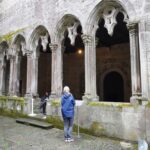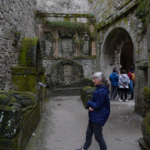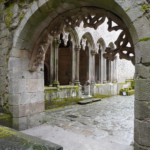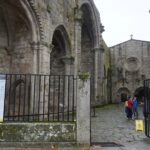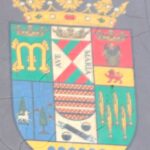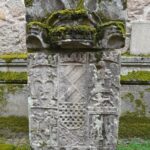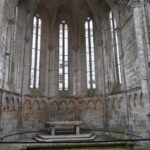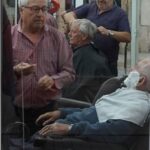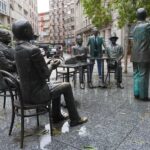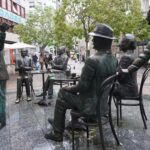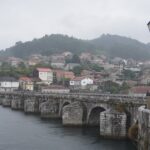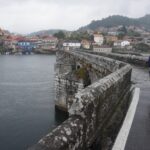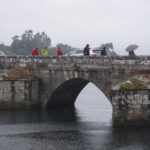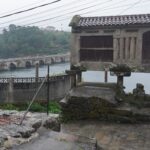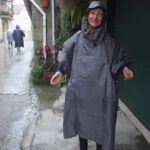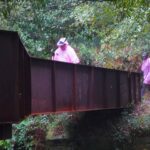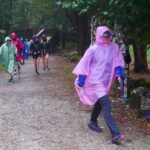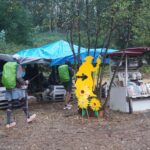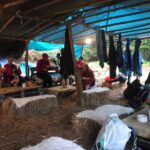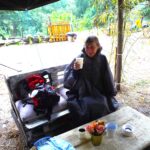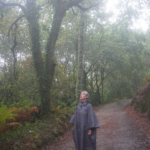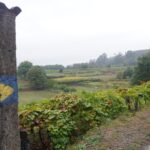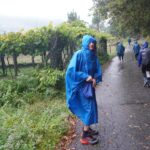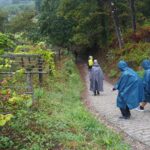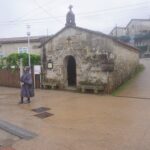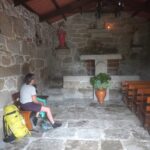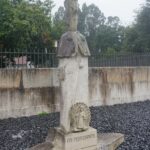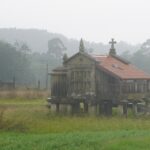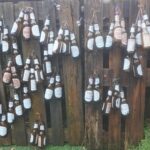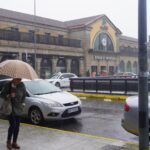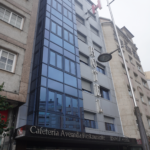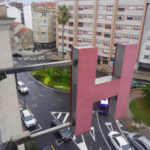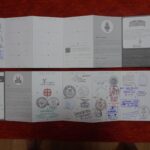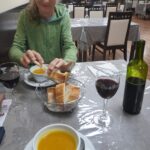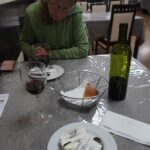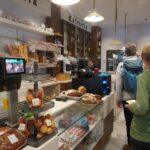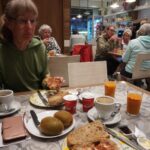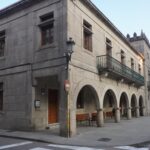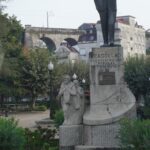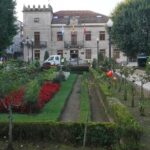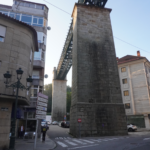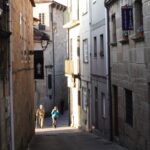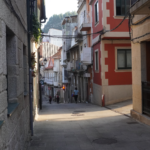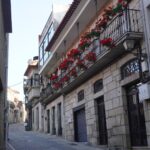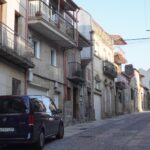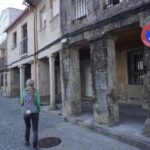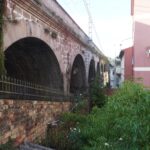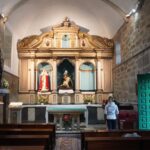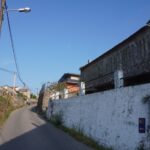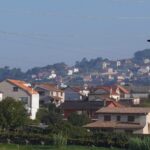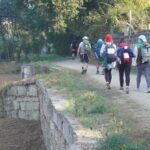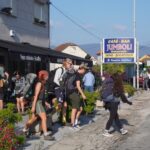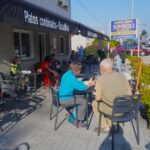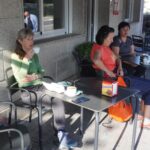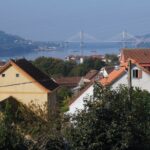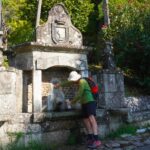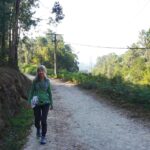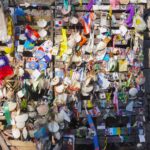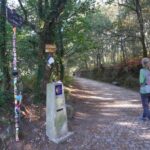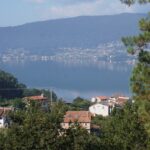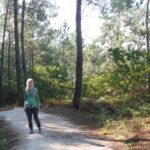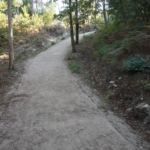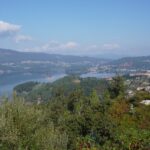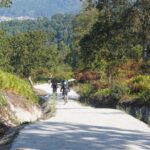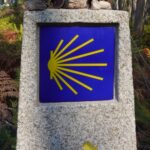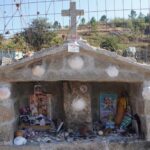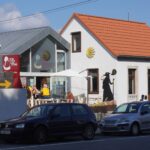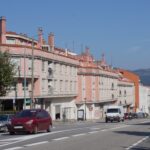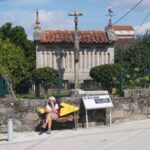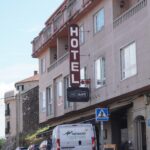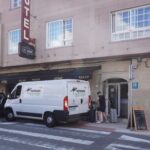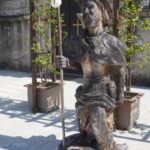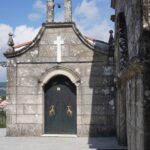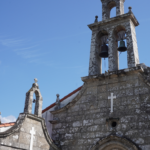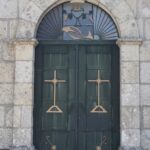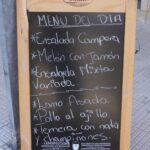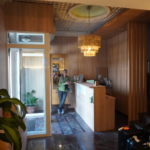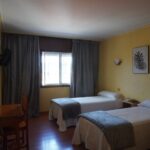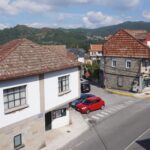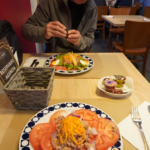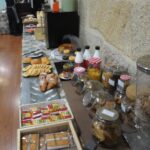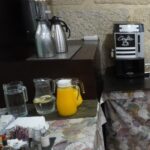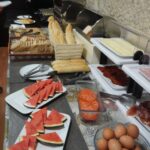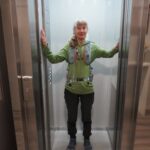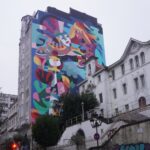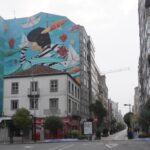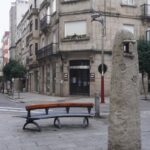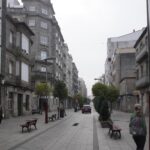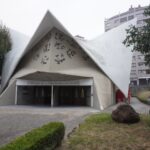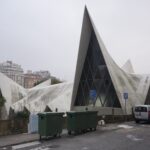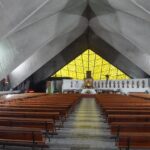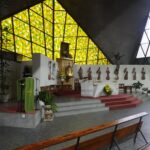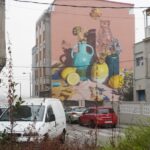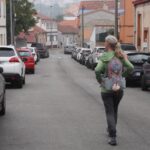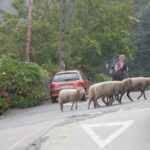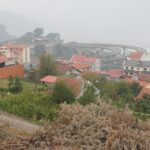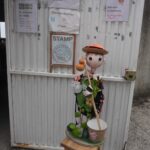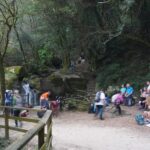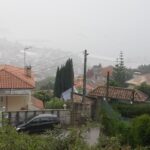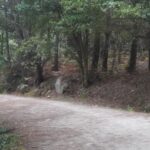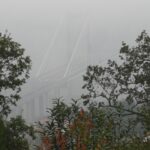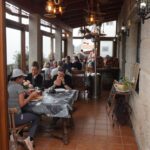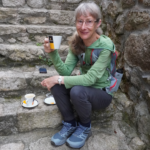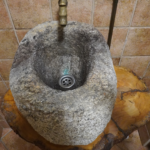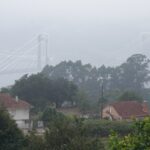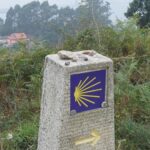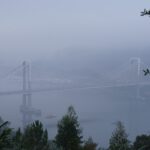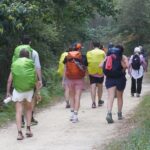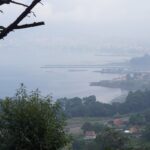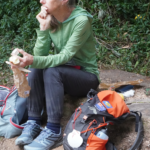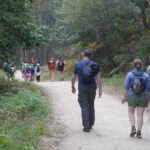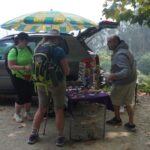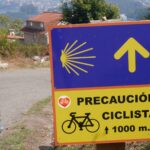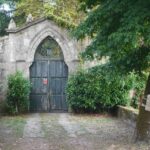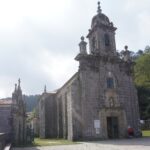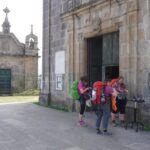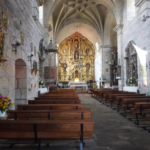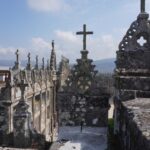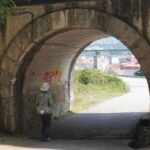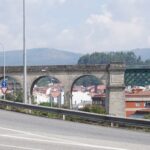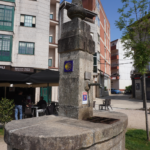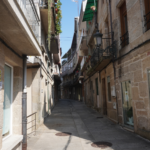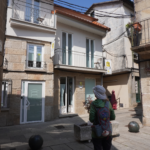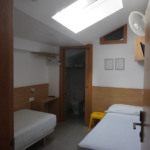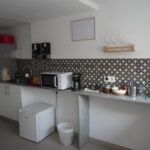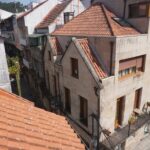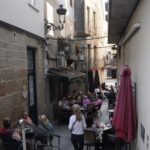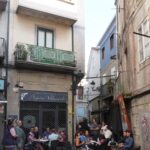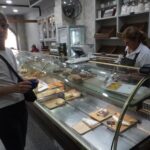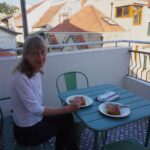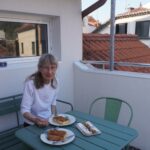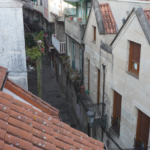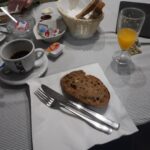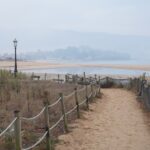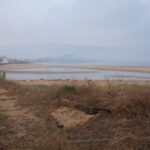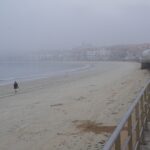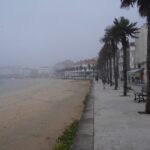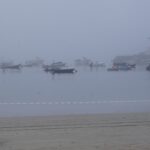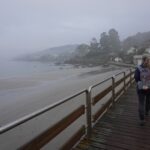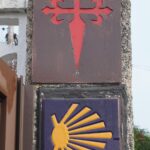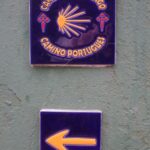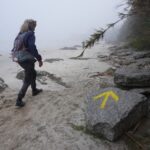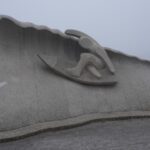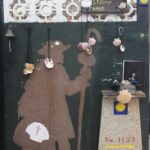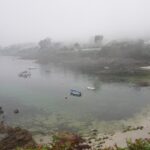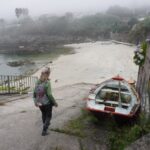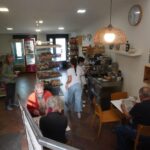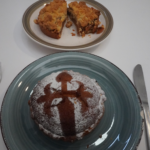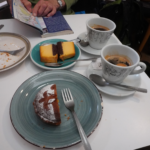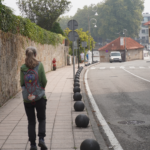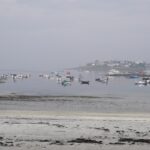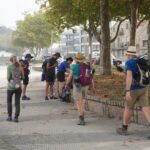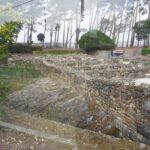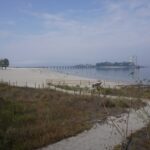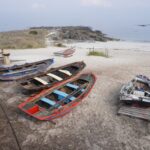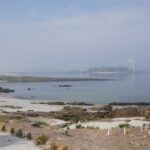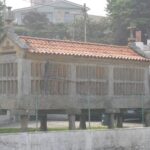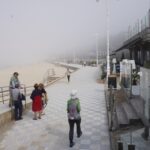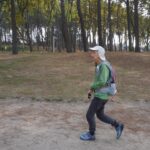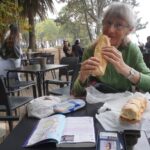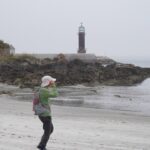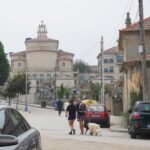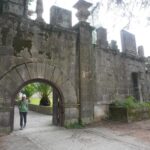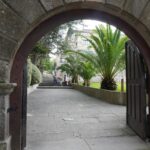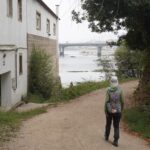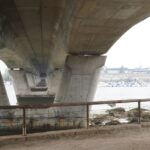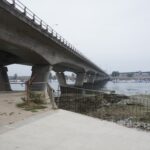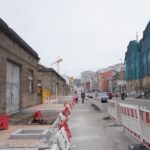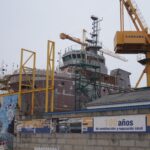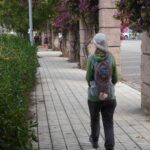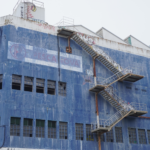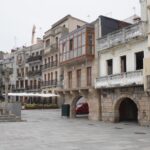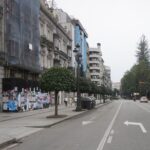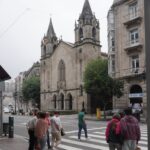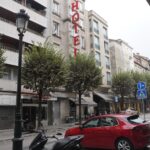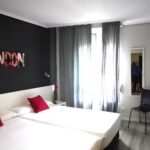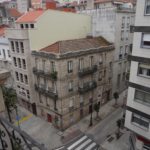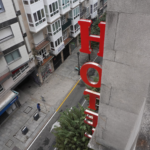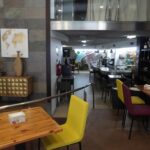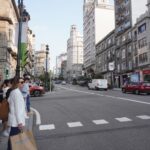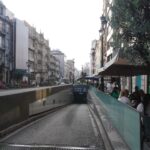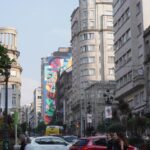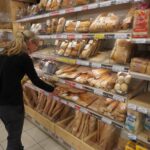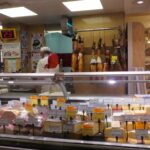Monthly Archives: September 2024
Santiago de Compostela
Teo to Santiago de Compostela 12kms
Total distance 270kms
Climb 80m
Total climb 3790m
We were hoping for an early departure so we would get to Santiago as soon as possible but breakfast didn’t start until 8.00am so we were a bit thwarted there. The path was nice at first, through some woodland and over a bit of a climb up to 260 metres. From this hill, far in the distance we could see the spires of the cathedral. As we got closer we started going through more and more built up areas with housing blocks, motorways, traffic lights, viaducts and all the usual stuff on entering a city. We did stop for coffee and a cake, mainly to use the bathroom.
The last half kilometre or so is through the narrow winding streets of the old town and the cathedral towers above you. The Camino Portuguese approaches the Cathedral and the square in front of it, Praza de Obradoira, from the south. Our previous approach on the Camino Frances is from the north and is more dramatic. There you go through about 2 kilometres of the old town and then down steps into a narrow arched tunnel where there is always a Galician bag piper playing. From this small dark space you burst out into the bright daylight of the plaza and the mighty cathedral.
We threaded our way through the narrow streets which were packed with people. It was a Sunday and a fun run was being held with the finish nearby. The plaza was also thronged with pilgrims and tourists and we could hear the wail of the bagpipes. The pilgrims, and us, have all the emotions, joy, excitement, relief, thankfulness, sadness (that the journey has ended and that you will part from your new friends), and even disappointment – because it was the journey that is important not the arrival at the destination.
In the plaza we had the obligatory photo taken, checked out the long, long queue to get into the cathedral, checked out where we were going to get lunch, checked out the Pilgrim Office where you get your Compostela, and checked out where our accommodation was located. It was all a bit overwhelming so we decided to sit down and have lunch and let everything slowly sink in. In a little side street off the plaza we went back to Restaurante Tarara where we had a few meals back in 2016. For €13 each an excellent pilgrim meal of bread, ham and cheese croquettes and veal lasagne for me, lentil and chorizo soup and roast chicken with salad for Barbara, followed by Santiago cake (made with ground almonds), and a bottle of vino tinto. We slowly ate outside under the umbrellas and just watched the world go by.
We felt a bit flat actually. In 2016 it was all much more exciting. We had walked for over 30 days on a much harder path and on reaching Santiago we had a great meal with over a dozen of our Camino friends and everyone was on a high. And we had our fresh tattoos. This time we knew absolutely no one in the thousands filling the town. Everyone else seemed to be having a great time and we felt it would have been better to also celebrate with friends.
We had not been sure about going to the Pilgrim’s Office, showing our passports full of stamps and getting a non-religious Compostela and Certificate of Distance, as we had done all this back in 2016. What convinced us was the fact that the only official count of the numbers walking Caminos is the number of Compostelas issued in Santiago. We wanted to be counted so went and got our Compostelas and certificates. It was about 2.30pm and over 1,100 had been issued so far that day. Late September is getting toward the end of the Camino season (April to Oct for the vast majority) and up to 300,000 certificates are issued each year.
We then went to our hotel and checked in. Our bags hadn’t arrived so we hung around until they showed up and then had a shower. Barbara rested up in the hotel and I went for a walk about in the old town. The queue at the cathedral wasn’t too long so I joined and got in after about 15 minutes. There is a security check and you are admitted in groups to control the number of people inside. You proceed up a little stair to behind the high altar where the tradition is to hug and give thanks to the large statue of St James. Then you proceed down to the crypt and reliquary chapel under the altar to view the silver casket alleged to contain the relics of St James. From there you are free to wander around all the cathedral. For a fee you can go up the towers and walk over the roof of the cathedral.
I went back to the hotel, roused Barbara and we went into the old town to revisit some of the places we remembered from 2016. Then we had some pizza, ice cream and coke for a truly decadent dinner.
- Breakfast Parada de Francos, Teo
- Breakfast Parada de Francos, Teo
- Teo to Santiago de Compostela
- Teo to Santiago de Compostela
- Teo to Santiago de Compostela
- Entering Santiago de Compostela
- Entering Santiago de Compostela
- Entering Santiago de Compostela
- First glimpse of cathedral, entering Santiago de Compostela
- Entering Santiago de Compostela
- Entering Santiago de Compostela
- Entering Santiago de Compostela
- Entering Santiago de Compostela
- Entering Santiago de Compostela
- Entering Santiago de Compostela
- Entering Santiago de Compostela
- Just over 5 kms to Santiago de Compostela
- Entering Santiago de Compostela
- Entering Santiago de Compostela
- Entering Santiago de Compostela
- Entering Santiago de Compostela
- Entering Santiago de Compostela
- Entering Santiago de Compostela
- Entering Santiago de Compostela
- Entering Santiago de Compostela
- Entering Santiago de Compostela
- Entering Santiago de Compostela
- Praza do Obradoiro, Santiago de Compostela
- Santiago Cathedral, Santiago de Compostela
- Santiago Cathedral, Santiago de Compostela
- Santiago Cathedral, Santiago de Compostela
- Santiago Cathedral, Santiago de Compostela
- Santiago Cathedral, Santiago de Compostela
- Santiago Cathedral, Santiago de Compostela
- Santiago de Compostela
- Santiago de Compostela
- Santiago de Compostela
- Santiago de Compostela
- Santiago de Compostela
- Santiago de Compostela
- Santiago de Compostela
- Santiago de Compostela
- Santiago de Compostela
- Santiago de Compostela
- Santiago de Compostela
- Santiago de Compostela
- Restaurante Tarara, Santiago de Compostela
- Restaurante Tarara, Santiago de Compostela
- Restaurante Tarara, Santiago de Compostela
- Checking our passports, Pilgrims’ Office, Santiago de Compostela
- Pilgrims’ Office, Santiago de Compostela
- Hotel Alameda, Santiago de Compostela
- Hotel Alameda, Santiago de Compostela
- Credencial, Pilgrim’s Passport
Penultimate walk
Padron to Teo 13kms
Total distance 258kms
Climb 260m
Total climb 3710m
We didn’t hear any trains last night so either there weren’t any or we were so tired we slept through them. Breakfast was super efficient this morning. No buffet, everything you were getting was on your table except for the juice and coffee. Not the most lavish breakfast, a yoghurt, piece of bread, ham, cheese, a croissant, butter and jam.
It is now 25kms to Santiago de Compostela and a lot of people do this in one day. We know our limitations so we are doing it in two days of 13km and 12 km respectively. Some people at breakfast clubbed together and ordered a taxi to take them the first 6 or 7 km to reduce the distance.
We had another leisurely start and walked back into Padron to look at the convent and its fountain. It was quite a varied day of walking. Natural pathways in the shade through oak, pine and eucalyptus woodland, the inevitable stretches of main road, quiet farm roads and little villages, and plenty of places to stop for food and drink. In two places there were musicians on the path which was nice. One of the sounds that is so cool each day is the church bells ringing out the hour and half hour. Even when not near a church the sound carries along the valleys. It is not always ‘live’ bells, you often see large speakers up in the church steeples and the bells look as though they haven’t moved in centuries.
Since Vigo, where the number of pilgrims probably increased ten fold, we have spoken to fewer people. This might seem odd but initially the majority of walkers were from outside Portugal and Spain; North Americans, Canadians, Europeans, Australians, Koreans, South Americans, etc. We were all aliens and there was a sort of bond between us as we navigated our way through this new culture. Now the vast majority of walkers are Spanish, in their homeland, and we foreigners are in the minority. Previously most had some form of English and communication wasn’t difficult. Now it is not so easy to recognise the non-Spanish speakers. We each have a small NZ flag on the back of our packs so people do come up to us and ask about NZ or talk about when they travelled there.
Our accommodation tonight is only the second time we have been in a house out in the country rather than a multi-storied hotel in a town or city. The other was 7 Uvas in Nigran. There is no lift of course and we are on the upper floor. We are in a lovely setting surrounded by trees and gardens. It is actually two buildings and the Camino Way runs between them. In one building is the accommodation and in the other is the restaurant. It is so quiet and peaceful and it is a warm sunny afternoon. When we arrived there were two musicians playing and singing and that just added to the atmosphere, but they have packed up and gone now.
Tomorrow is our last day on The Camino Portuguese. Not really sure how we feel about it. In 2016 when we finished the Camino Frances after 800km and a month of walking there was a huge sense of accomplishment and thankfulness that our bodies had held together pretty well. This time is different. The distance is much shorter and the walking has been a lot easier, and it is never quite the same when you do something the second time around.
- Breakfast, Rosalia Hotel, Padron
- The guys who move the bags, Rosalia Hotel, Padron
- Convento do Carme, Padron
- Fonte do Carme, Padron
- Fonte do Carme, Padron
- Convento do Carme, Padron
- View of Padron from Convento do Carme, Padron
- Convento do Carme, Padron
- Leaving Convento do Carme, Padron
- Convento do Carme, Padron
- Cementerio de Adina, Padron
- Igrexa de Santa Maria de Iria Flavia, Padron
- Igrexa de Santa Maria de Iria Flavia, Padron
- Igrexa de Santa Maria de Iria Flavia, Padron
- Padron to Teo
- Padron to Teo
- Padron to Teo
- Padron to Teo
- Padron to Teo
- Padron to Teo
- Padron to Teo
- Padron to Teo
- Padron to Teo
- Padron to Teo
- A Escravitude
- Igrexa da Escravitude, A Escravitude
- Igrexa da Escravitude, A Escravitude
- Igrexa da Escravitude, A Escravitude
- Igrexa da Escravitude, A Escravitude
- Igrexa da Escravitude, A Escravitude
- Igrexa da Escravitude, A Escravitude
- Igrexa da Escravitude, A Escravitude
- Bar and Restaurante Buen Camino, A Escravitude
- Bar and Restaurante Buen Camino, A Escravitude
- Igrexa da Escravitude, A Escravitude
- Iglesia de Santa Maria de Cruces, A Escravitude
- Iglesia de Santa Maria de Cruces, A Escravitude
- Cemiterio da Escravitude
- Iglesia de Santa Maria de Cruces, A Escravitude
- Iglesia de Santa Maria de Cruces, A Escravitude
- Padron to Teo
- Padron to Teo
- Padron to Teo
- Padron to Teo
- Padron to Teo
- Padron to Teo
- Padron to Teo
- Musicians at Casa Rural Restaurante Parada de Francos, Teo
- Musicians at Casa Rural Restaurante Parada de Francos, Teo
- Casa Rural Restaurante Parada de Francos, Teo
- Casa Rural Restaurante Parada de Francos, Teo
- Casa Rural Restaurante Parada de Francos, Teo
- View from room, Casa Rural Restaurante Parada de Francos, Teo
- Parada de Francos, Teo
- Parada de Francos, Teo
- Parada de Francos, Teo
- Parada de Francos, Teo
Train Whistle Blowing
Caldas de Reis to Padron 22kms
Total distance 245kms
Climb 260m
Total climb 3450m
Another wonderful day of walking. We are getting a little blase over these. This morning we left Caldas de Reis crossing a beautiful little three arch rebuilt Roman bridge, Ponte Romana do Rio Bermana, over the Rio Bermana. It also had an old drinking fountain. This afternoon we entered Padron crossing a thirteen arch medieval bridge, Ponte de Padron, over the Rio Ulla, This bridge is built over a bridge of Roman origin built about 25AD and is sometimes called Ponte Romana. Once in Padron we also saw the Ponte de Santiago, a stone bridge of 1852, built over the Rio Sar.
Most of today was on natural pathways through urban areas, woodland, farms and vineyards. The route took us along two river valleys, firstly the Bermana and then the Valga. There was a gentle climb up to about 160 metres between them. The morning was crisp but clear so it was ideal walking conditions. It wasn’t all perfect. We had to cross busy roads a few times and walk alongside them for short periods. Not far out of Caldas de Reis we walked under a high concrete viaduct carrying a motorway. The train wasn’t too far away either and entering Padron we had to wait at a crossing for the intercity renfe train to pass.
Our hotel, the Rosalia, is about a kilometre out of Padron in a semi industrial and rural area and is directly opposite the Padron railway station. There seems to be a train about every 30 minutes and they all pick or drop off passengers at this station. The trains are very sleek and modern looking and are diesel-electric I think, so are a bit noisy. They make the most pathetic little toot sound as they go over a crossing. What you might expect on a toy train, not a loud blast you imagine from a high speed intercity train. We are hoping the trains don’t run all night although our hotel room seems to have good quality acoustic double glazing.
There were few eating places to stop at today and we didn’t have much food with us. Our first stop was Cafe-Bar Esperon in O Cruceiro, for a coffee and muffin. Because there are so many pilgrims these last few days, these cafes are packed with long lines getting food and drink and using the toilets. The staff are under a lot of pressure but are almost always good natured trying to take orders in at least a dozen different languages. In Portugal and Spain we generally order a cafe americano, or cafe longo, which is near enough to a long black we would get at home. The young guy at Esperon must have mis-heard or misunderstood our order as he made two coffees with leche, milk. We said we don’t want milk and we got a bit of a dirty look and exclamation, but he did put those two coffees aside and make us two new ones.
Later we stopped at Buen Camino Bar in San Miguel where Barbara had galician soup (ham hocks, lima beans, potato, cabbage, kale) and I had gazpacho (tomato, olive oil, vinegar, onion, spices, served cold). This was in a nice setting above the road overlooking the Church and Cemetery of San Miguel de Valga.
Today we got a stamp in our Credencial from The Guardia Civil (the Civil Guard). This is one of two national law enforcement agencies. As a national gendarmerie, it is a military force and is responsible for civil policing under the authority of both the Ministry of the Interior and the Ministry of Defence. We had seen them a couple of days ago but didn’t realise what they were doing. This was basically a public relations exercise. They had a van and a couple of soldiers and had their own stamp and were just chatting with pilgrims.
Padron has a long history and is supposed to be the starting point of where St James preached the Gospel in Spain, and also the point where his remains returned to Spain after his martyrdom in Jerusalem. So there are many sacred churches, convents, fountains, altar stones etc, in the town.
We arrived at our hotel at 2.30 and dinner is not until 8.00. There is not much to see in this area so we have had a lazy afternoon just relaxing and filling in time train spotting.
- Leaving Caldas de Reis
- Puente Romana, Caldas de Reis
- Drinking Fountain and Puente Romana, Caldas de Reis
- Puente Romana, Caldas de Reis
- Puente Romana, Caldas de Reis
- Caldas de Reis to Padron
- Caldas de Reis to Padron
- Caldas de Reis to Padron
- Caldas de Reis to Padron
- Caldas de Reis to Padron
- Caldas de Reis to Padron
- Caldas de Reis to Padron
- Cobblestone paths, Caldas de Reis to Padron
- Cafe Bar Esperon, O Cruceiro
- Cafe Bar Esperon, O Cruceiro
- O Cruceiro
- Iglesia de Santa Marina de Carracedo
- Iglesia de Santa Marina de Carracedo
- Iglesia de Santa Marina de Carracedo
- Caldas de Reis to Padron
- Caldas de Reis to Padron
- Caldas de Reis to Padron
- Buen Camino Bar, San Miguel
- Buen Camino Bar, San Miguel
- Buen Camino Bar, San Miguel
- Buen Camino Bar, San Miguel
- Iglesia de San Miguel de Valga
- Iglesia de San Miguel de Valga
- Iglesia de San Miguel de Valga
- San Miguel to Padron
- San Miguel to Padron
- Contrast of wood processing plant and church, Padron
- Entering Padron
- Waiting for train, Padron
- Entering Padron
- Ponte de Padron, Rio Ulla, Padron
- Ponte de Padron, Rio Ulla, Padron
- Roman bridge, Rio Ulla, Padron
- Padron
- Padron
- Padron
- Convento do Carme and Santiago bridge over Rio Sar, Padron
- Iglesia de Santiago, Padron
- Directions to Rosalia Hotel, Padron
- Rosalia Hotel Padron
- Rosalia Hotel, Padron
- Padron Railway Station
- Rosalia Hotel, Padron
- View from Hotel Roaslia, Padron
- Panorama from Hotel Rosalia, Padron
- Padron Railway Station and Renfe train
STOP Complaining
Pontevedra to Caldas de Reis 22kms
Total distance 223kms
Climb 160m
Total climb 3190m
What a great day of walking. It rained all night (100mm) and was raining when we woke up this morning but by the time we had finished breakfast it had stopped. We put our rain jackets on when we departed as we thought there might be some showers hanging about. At one stage Barbara put on her poncho but a brief light shower came to nothing and we had a dry day. It was warm, a bit muggy and we had a nice little tail breeze for much of the day.
Leaving Pontevedra we passed the Fountain of the Children which has water spouts that come up out of the pavement. It wasn’t playing this morning but there were two cute little statues of children. From there we called into the Convent of San Francisco hoping to get a stamp for our passport, but although the church was open we had no joy, maybe we just weren’t pious enough. We passed through a couple of the lovely historic squares in the Old Town. The Lena Square which gets its name from the sale of firewood. It dates from the 15th century and is surrounded by typical houses and the Provincial Museum. In the centre of the square is a stone transept. Two buildings of the museum are linked by a graceful bridge. The second was the Verdura Square, the Vegetable Square, which gets its name from the products sold there, vegetables, chestnuts and fruit. The arcades of the buildings house old typical taverns. It dates from the 1330s and a market was held here every day except Sundays and public holidays until 1990.
From there we crossed the Ponte O Burgo medieval bridge we saw yesterday.
Although Pontevedra is a sizeable city (pop 80,000) and a university city, we were quickly out of town and into the countryside on natural pathways through woodland offering shade along gentle river valleys. We shared the day with a railway line which was sometimes at ground level and other times on a viaduct spanning small valleys. We saw several fast passenger trains and one freight train over the course of the day.
We are now in an endless stream of pilgrims, all on the same mission. There seems to be a lot more Spanish pilgrims now, doing their 100km to Santiago. Most of today’s walk was through countryside with only two villages that had cafes. The numbers mean the cafes and their conveniences are packed as almost everyone wants to stop for a break. We have learnt not to stop at the first cafe you come across, but to go further into a village where you often find a quieter and cheaper one. The second half of the day was through vineyards. Many of the vines had ripe grapes ready for picking. The soil is good here and the rain in Galicia is regular.
Caldas de Reis is famous for its thermal baths. Its history is inextricably linked to its thermal waters that have gushed from its ground source at a constant 40° for millennia. Already inhabited by people such as the Cyclenes and the Celts, it became a major spa with the arrival of the Romans and was on the Via Romana XIX. Today we passed several markers showing the route of Via Romana XIX. This was a Roman road from the time of Augustus (63BC -AD14) linking the towns of Braga, Pontevedra, Calaz de Reis, Santiago, Lugo and Astorga in northern Spain.
We arrived at our hotel at 2.30 just as the Tuitrans van turned up with our bags, so good timing. In the lobby we met the first Kiwi we have come across. A young lady from Martinborough. She said she was finding the walking and hills very easy as she was a tramper and spent a lot of time in the Tararuas.
- Stop complaining, Pontevedra to Caldas de Reis
- Fonte dos nenos, Pontevedra
- Fonte dos nenos, Pontevedra
- Convent of San Francisco, Pontevedra
- Convent of San Francisco, Pontevedra
- Convent of San Francisco, Pontevedra
- Lena Square, Pontevedra
- Lena Square, Pontevedra
- Lena Square, Pontevedra
- Lena Square, Pontevedra
- Lena Square, Pontevedra
- Lena Square, Pontevedra
- Verdura Square, Pontevedra
- Verdura Square, Pontevedra
- Paul and friend, Verdura Square, Pontevedra
- Old Town, Pontevedra
- Old Town, Pontevedra
- Ponte dos Tirantes, Pontevedra
- Leaving Pontevedra
- Igrexa de Santa Maria de Alba
- Cemiterio de Santa Maria de Alba
- Cemiterio de Santa Maria de Alba
- Pontevedra to Caldas de Reis
- Pontevedra to Caldas de Reis
- Pontevedra to Caldas de Reis
- Pontevedra to Caldas de Reis
- Pontevedra to Caldas de Reis
- Pontevedra to Caldas de Reis
- Pontevedra to Caldas de Reis
- Meson Don Pulpo, San Mauro, Pontevedra to Caldas de Reis
- Capilla de San Amaro de Barro, San Mauro, Pontevedra to Caldas de Reis
- Capilla de San Amaro de Barro, San Mauro, Pontevedra to Caldas de Reis
- Via Romana XIX, Pontevedra to Caldas de Reis
- Pontevedra to Caldas de Reis
- Pontevedra to Caldas de Reis
- Pontevedra to Caldas de Reis
- Pontevedra to Caldas de Reis
- Lunch next to Oasis Cafe, Pontevedra
- 40km via the road, 50km via the Camino
- Vineyards Caldas de Reis
- Vineyards Caldas de Reis
- Vineyards Caldas de Reis
- Vineyards Caldas de Reis
- Vineyards Caldas de Reis
- Drinking fountain, Tivo
- Entering, Caldas de Reis
- Iglesia de Santa Maria de Caldas de Reis
- Rio Umia, Caldas de Reis
- Caldas de Reis
- Caldas de Reis
- Caldas de Reis
- Caldas de Reis
- Hotel O Cruceiro, Caldas de Reis
- Hotel O Cruceiro, Caldas de Reis
- View from Hotel O Cruceiro, Caldas de Reis
- Dinner Hotel O Cruceiro, Caldas de Reis
- Dinner Hotel O Cruceiro, Caldas de Reis
- Dinner Hotel O Cruceiro, Caldas de Reis
Something fishy going on
A day in Pontevadra
This is the last of our rest days and a very casual one it was. With no particular plan we wandered around the historic area of Pontevedra.
Pontevedra (pop 85,000) is best known for the charm of its old town. It is the second most important historic town in Galicia after Santiago de Compostela. A city of art and history it is known as “The Good City”. It has a historic group of medieval squares and many monumental religious buildings and noble houses. Best of all it is a walkable city with all of the old town pedestrianised.
The following are some of the places and things we saw.
The Church of the Pilgrim Virgin is a scallop-shaped Roman Catholic chapel located on the route of the Camino Portuguese. Consecrated in 1794. It is one of the most symbolic and important buildings in the city of Pontevedra. It is dedicated to the Virgin who, according to tradition, guided pilgrims from Bayona in the south-west of the province of Pontevedra to Santiago de Compostela. The shape of its floor plan is inspired by a scallop shell, the quintessential symbol of pilgrims, ending in a Christian cross.
The Pontevedra Municipal Market, a covered market , where you find stalls selling fish, meat, vegetables, fruit, cheese, bread, flowers, chestnuts, and with restaurants and cafes. It is a large granite two-storey rectangular structure with columns, arches and arcades. It is home to the Pontevedra fish market and this is the overwhelming smell in the hall. If you don’t like the smell of fish you won’t last long wandering around this market. We didn’t last long.
The ruins of Santo Domingo, a 12th century Dominican Convent. This was a fine Gothic church and construction and enlargement carried on throughout the 15th century. In 1719, during the English attack on Pontevedra, troops burned down the convent and church. There isn’t a lot of this convent left, just the entrance portico and five small chapels. It is part of the Museum of Pontevedra and has a permanent exhibition of stone pieces and tombs relating to the history of the city.
Burgo Bridge, a medieval bridge that crosses the Lerez River. This is another bridge that replaced a previous bridge of Roman origin. It is located on the route of the Camino Portuguese and between its arches on top of pillars are sculpted the pilgrim shells. The pedestrian only bridge you see today is vastly different from the narrow bridge built in the 12th century having been repaired and rebuilt and had constant modifications over eight centuries. Part of the original Roman bridge has been excavated on the Pontevedra side of the bridge.
Not far from this bridge is a very elegant modern asymmetrical cable-stayed bridge crossing the same river. It has a high inclined concrete tower with 17 pairs of steel cables, the front ones holding the concrete bridge deck and the rear ones tied to two underground concrete bases acting as counterweights. It was very calm today but apparently when there is wind the cables make a characteristic and spectacular noise.
At the hotel reception we had our bus tickets (bilettes) from Santiago back to Lisboa printed off. We had booked these online a few days ago and had them as a QR code on our phones, but we are old fashioned and a bit paranoid and like to have paper copies of everything. I guess your phone could be lost or stolen, just die or get water-logged in the rain. I had transferred them to a USB stick and the helpful man at reception had them printed in a minute. We could also have sent them to the hotel web site and had them printed a bit more indirectly that way.
It was forecast to be a very wet day today but it wasn’t bad this morning. A few showers and we made use of the cafe umbrellas for a coffee and churros during the heaviest of them. Also managed to be in the Market for another shower. Steady rain in the afternoon so retreated to the hotel. Fortunately dinner tonight is in the dining room in the hotel so we don’t have to venture outside.
- Breakfast, Hotel Avenida, Pontevedra
- Spice shop, Pontevedra
- Sweet pastries, Pontevedra
- Igrexa da Virxe Peregrina, The Church of the Pilgrim Virgin, Pontevedra
- Igrexa da Virxe Peregrina, The Church of the Pilgrim Virgin, Pontevedra
- Igrexa da Virxe Peregrina, The Church of the Pilgrim Virgin, Pontevedra
- Igrexa da Virxe Peregrina, The Church of the Pilgrim Virgin, Pontevedra
- Igrexa da Virxe Peregrina, The Church of the Pilgrim Virgin, Pontevedra
- Igrexa da Virxe Peregrina, The Church of the Pilgrim Virgin, Pontevedra
- Pilgrims leaving Igrexa da Virxe Peregrina, The Church of the Pilgrim Virgin, Pontevedra
- You are in Pontevedra
- Pontevedra
- Igrexa da Virxe Peregrina, The Church of the Pilgrim Virgin, Pontevedra
- Convent of San Francisco, Pontevedra
- Convent of San Francisco, Pontevedra
- Convent of San Francisco, Pontevedra
- Igrexa da Virxe Peregrina, The Church of the Pilgrim Virgin, Pontevedra
- Pontevedra
- Pontevedra
- Pontevedra
- Pontevedra
- Pontevedra
- Pontevedra
- Water fountain, Pontevedra
- Pontevedra
- Pontevedra
- Pontevedra
- Ponte do Burgo over Lerez River, Pontevedra
- Ponte do Burgo over Lerez River, Pontevedra
- Ponte dos Tirantes over Lerez River, Pontevedra
- Ponte dos Tirantes over Lerez River, Pontevedra
- Ponte dos Tirantes over Lerez River, Pontevedra
- Street sculpture, Pontevedra
- Mercado Municipal, Pontevedra
- Mercado Municipal, Pontevedra
- Mercado Municipal, Pontevedra
- Mercado Municipal, Pontevedra
- Mercado Municipal, Pontevedra
- Mercado Municipal, Pontevedra
- Mercado Municipal, Pontevedra
- Coffee and churros, Pontevedra
- Pontevedra
- Pontevedra
- Ruins of Santo Domingo, Pontevedra
- Ruins of Santo Domingo, Pontevedra
- Ruins of Santo Domingo, Pontevedra
- Ruins of Santo Domingo, Pontevedra
- Ruins of Santo Domingo, Pontevedra
- Ruins of Santo Domingo, Pontevedra
- Ruins of Santo Domingo, Pontevedra
- Ruins of Santo Domingo, Pontevedra
- Ruins of Santo Domingo, Pontevedra
- Ruins of Santo Domingo, Pontevedra
- Ruins of Santo Domingo, Pontevedra
- Haircut and a shave, Pontevedra
- Street sculpture, Pontevedra
- Street sculpture, Pontevedra
The Rain in Spain Stays Mainly on the Plain. Not !
Arcade to Pontevedra 12kms
Total distance 213kms
Climb 360m
Total climb 3030m
Rain was forecast for today and yes it came exactly on time at 8.00am. Yet still it was a beautiful day’s walk, how could that be? It was warm, no wind and the path was outstanding.
As you leave Arcade you cross the Verdugo River over the medieval bridge of Pontesampio. This bridge is built on a Roman foundation and was constructed in the 11th and 12th century. The stone bridge is 144 metres long and has 10 pointed arches. It is only 3 metres wide, so just wide enough for a car. All the pilgrims cross the bridge and it is still used by some cars. Not much room to step aside as a car comes by. The bridge is famous for the Battle of Puente Sampayo when Napolean’s French army was defeated by the Spanish in June 1809 during the Peninsular War. The battle marked the final evacuation of Galicia by the French army.
At the bridge we put on our ponchos. Prior to this we just had on our rain jackets but the ponchos are much better in steady rain and also go over our packs. We now really felt like pilgrims as we joined the throng of billowing sails gliding along the path. Immediately after the river we started climbing the Alto da Canicouva, a 145 metre high climb and the only one for the day. The path wound up and down through forest and vineyards and everything was very green. Despite the rain it was very pleasant and serene.
After an hour or so we came to what we thought was a little camp but turned out to be A Prarado Do Camilo Cacheiro, a pop up cafe with a large temporary shelter. Most people stopped just to get out of the rain for a while, but we got a stamp, had a coffee and chatted with an American couple from Virginia. The seating under the shelter was on hay bales, very rustic. Something else we came across for the first time today was large barns that housed high intensity cattle farming. These places absolutely stink and we can’t get past them fast enough.
There were no public toilets on the path today and about an hour after our coffee stop we were getting a bit desperate. Luckily we came to a little cafe/bar, Bar Church.2, and used their toilets. For the convenience of their conveniences we bought some snacks and carried on.
By noon we had reached Pontevedra and went into the railway station to get out of the rain and consult our guide book and the phone app. Our hotel was only 8 minutes away. We were at the hotel very early but they did have a room ready for us. No bags though, so we couldn’t get into dry clothes yet. We did dry off a bit then went back out to a huge Aldi Store to buy some things for lunch. We did have a shower but had to get back into our wet dirty clothes. Eventually at 4pm our bags showed up.
We seem to be obsessed with food but when you are walking most of the day, your evening meal becomes quite important. Hotel Avenida has a pilgrim menu and dining starts at 6.30pm. Yeah! We were there at 6.30 on the dot, first into the dining room and first to eat. Bread and three course meal with wine and we were out of there in an hour. As we were leaving the really noisy group from last night were drifting in. Thank God, or St James, we missed them.
We have a rest day here tomorrow so will explore the old quarter of Pontevedra and get all the washing dry. Unfortunately the forecast is for rain most of the day, 73mm. There is a rain warning out. May have to buy an umbrella if we go out sight seeing.
- Bags waiting for pick up, Hotel Isape, Arcade
- Bridge of Pontesampio over Verdugo River, Arcade
- Bridge of Pontesampio over Verdugo River, Arcade
- Bridge of Pontesampio over Verdugo River, Arcade
- Bridge of Pontesampio over Verdugo River, Arcade
- Ponch goes on, leaving Arcade
- Arcade to Pontevedra
- Arcade to Pontevedra
- Arcade to Pontevedra
- Arcade to Pontevedra
- Cafe A Prarado Do Camilo Cacheiro, Arcade to Pontevedra
- Cafe A Prarado Do Camilo Cacheiro, Arcade to Pontevedra
- Cafe A Prarado Do Camilo Cacheiro, Arcade to Pontevedra
- Cafe A Prarado Do Camilo Cacheiro, Arcade to Pontevedra
- Arcade to Pontevedra
- Arcade to Pontevedra
- Vineyards, Arcade to Pontevedra
- Paul in Poncho, Arcade to Pontevedra
- Arcade to Pontevedra
- Capela da Santa Marta, 1617, Vilaboa
- Capela da Santa Marta, 1617, Vilaboa
- Monument to pilgrims, Casal de Rio
- A horreo with a lean-to, Casal de Rio
- Pilgrim bottles of beer, Bar Church.2, Casal de Rio
- Railway Station, Pontevedra
- Hotel Avenida, Pontevedra
- Hotel Avenida, Pontevedra
- View from Hotel Avenida, Pontevedra
- Our Pilgrim Passport is filling up
- Hotel Avenida, Pilgrim Menu, Pontevedra
- Hotel Avenida, Pilgrim Menu, Pontevedra
- Hotel Avenida, Pilgrim Menu, Pontevedra
The Bag Man and Oysters
Redondela to Arcade 8kms
Total distance 201kms
Climb 120m
Total climb 2670m
We knew today was going to be a comfortable day. Only 8km to Arcade, so we had a pretty relaxed start. Breakfast was at a panadaria/pasteleria, Cafeteria O Cruceiro, the typical continental breakfast. We then had a look around Redondela. At 30,000, This town has only a tenth of the population of our last stop, Vigo, and so has a much friendlier, intimate feel. Its main characteristic is its sky which is dominated by two large railway viaducts built in the nineteenth century. These span the valley that the town is built in, and have great masonry arches at each end and a steel lattice structure between. Redondela is sometimes known as the “Villa of the Viaducts”. I wasn’t aware of any trains on the viaducts when we were there, but it must be quite a thing to hear trains rumbling hundreds of feet above your head when you are in the narrow little lanes of the town.
Before leaving Redondela we bought some bread, chocolate, banana, apple, mandarin and nuts to have for lunch somewhere later in the day. We also bought some bottled water as the water in our hotel had tasted musty. There are quite a few drinking fountains along the way but these sometimes have signs “no beber” or “agua no potable.” We didn’t leave town till after 9.30 (the supermarkets don’t open until 9.00) and so we were behind most of the long procession of pilgrims. We stopped at the Chapel of Santa Marina to collect a stamp for our passports. Some of the churches and chapels are not open so we take the opportunity to get a stamp (sella) when we see one open. It is pretty easy to get the stamps at hotels, cafes, bars, shops, tourist offices etc, but the ones from churches seem more genuine somehow.
It was a nice walk out of town along the narrow streets and climbing a hill as we left suburbia. A coolish morning at 15° but much clearer than the last few days. At our morning coffee stop we got talking with a couple from Adelaide who had started walking a couple of days ago from Tui. They were a bit younger than us (everyone on the Camino seems a bit, or a lot, younger than us) and after getting to Santiago they were going to have some time in Malta, which sounded an interesting thing to do. We noticed the guy had some tattoos on his arm so asked him if he would get another one in Santiago and showed him ours. He didn’t know about the tradition of getting a scallop shell tattoo but was very keen and said he had an empty spot on his arm. His wife was not so keen.
From the cafe we climbed a steep hill and into forest. It was beautiful walking up there with occasional views down to the Rio Viga and the Puente de Rande suspension bridge we saw through the fog yesterday. Then a steep descent into Arcade where we stopped in a park to eat our lunch. It seems a scruffy little town but is popular because of one of the most popular dishes in the Galicia region – oysters. On the first weekend of April there is an “Oyster Festival” where you can try this seafood and enjoy the music and festive atmosphere of a typical Galician food festival. Oysters were appreciated here in Roman times and to this day are exported from Arcade. They are not born here, they grow here. The small offspring come from France and Greece and are cultivated in the waters of the Arcade estuary over the course of two or three years. This gives them a special, unmistakable and unique flavour that delights oyster lovers. Of which we are not one.
Opposite our hotel is the small Church of Santiago de Arcade dating from the end of the 12th Century. It was locked so we couldn’t enter but apparently a series of unsuccessful changes have destroyed practically all the original Romanesque elements. Even the front facade has been compromised by the addition in the 1960s of a church hall.
Today we saw the guy who transfers our bags each day. The bags have to be down in the hotel lobby by 8.00 am and we don’t see them until we arrive at our next hotel in the afternoon, and there they are, waiting for us in the lobby. Somehow the elves have done their magic. Today as we walked up to the Hotel Isape in Arcade we saw a white van with Tuitrans emblazoned on it and a young guy unloading bags and cases. I knew Tuitrans was the company doing our bag transfer and our bags were unloaded along with 24 others. He was also loading bags into the van from Isape and already had a load of bags in the van off to somewhere else. There are lots of tour companies, using lots of hotels and pensions in heaps of towns. Just how to make this happen in the most efficient way must be a logistical nightmare.
- Breakfast Cafeteria O Cruciero, Redondela
- Breakfast Cafeteria O Cruciero, Redondela
- Redondela
- Redondela
- Redondela
- Railway viaduct, Redondela
- Railway viaduct, Redondela
- Railway viaduct, Redondela
- Railway viaduct, Redondela
- Redondela
- Redondela
- Redondela
- Redondela
- Redondela
- Railway viaduct, Redondela
- Chapel of Santa Marina, Redondela
- Chapel of Santa Marina, Redondela
- St James, Chapel of Santa Marina, Redondela
- Redondela to Arcade
- Redondela to Arcade
- Redondela to Arcade
- Redondela to Arcade
- Coffee, Jumboli Cafe, Redondela to Arcade
- Coffee, Jumboli Cafe, Redondela to Arcade
- Coffee, Jumboli Cafe, Redondela to Arcade
- Puente de Rande, Redondela to Arcade
- Redondela to Arcade
- Rio Viga Estuary, Redondela to Arcade
- Rio Viga Estuary, Redondela to Arcade
- Arcade
- Arcade
- Arcade
- Arcade
- Arcade
- Hotel Isape, Arcada
- Luggage transfer, Hotel Isape, Arcada
- Church of Santiago de Arcade
- Church of Santiago de Arcade
- Church of Santiago de Arcade
- Church of Santiago de Arcade
- Church of Santiago de Arcade
- Church of Santiago de Arcade
- Menu of the Day, Hotel Isape, Arcada
- Hotel Isape, Arcada
- Hotel Isape, Arcada
- View from room, Hotel Isape, Arcada
- View from room, Hotel Isape, Arcada
Just back from dinner. The noisiest dinner ever. A small dining room with about 50 people and terrible acoustics. One very, very noisy group of 17, 15 women and two men. Of course the noise level in the room went up and up as everyone had to shout over each other to be heard. We and others were sitting there with fingers in ears. And it took an hour and three quarters.
- Dinner, soooo loud, Hotel Isape, Arcada
- Dinner, Hotel Isape, Arcada
- Dinner, Hotel Isape, Arcada
- Dinner, Hotel Isape, Arcada
Up on the roof
Vigo to Redondela 15kms
Total distance 193kms
A huge difference on the Camino today. There are about ten times as many people walking. Vigo is a popular starting point for people with limited time who just want to do the last 100km to Santiago. They of course are fresh, keen, noisy and excited and walk much faster than we who have been on the trail for longer. There is a difference in age make up as well. Previously the majority of pilgrims were of about our age. Now there is a much broader age spread with a lot of young ones in their twenties. We walked with a group of three couples from Galway Ireland. Yesterday, Saturday, they had flown from Galway to Santiago and then got a taxi to Vigo. Today they started their pilgrimage back to Santiago and will finish next Saturday and fly home Sunday. So a weeks annual leave and they can walk 100km of the Camino Portuguese. So easy when you live in Europe.
Yet another foggy morning as we left Vigo. The first five kilometres were slightly uphill through residential areas before we reached a ridge. From there it was flat, through woodland on a dirt trail, so it was very easy walking. There should have been nice views down to the coast but we couldn’t see much. There was a large, elegant suspension bridge carrying the motorway over the River Vigo but we couldn’t see it till later in the morning when it emerged from the fog. Walking through the forest was perhaps the most pleasant part of this trip so far.
This morning we met up again with one of our new friends, Kathy. We hadn’t seen her for a day or two because we had rest days in different locations. Her walking companion, Aussi Rosemary, left the Camino today and took the train to Madrid. Kathy is a straight talking lady from New York. She is one of those people who can strike up a conversation with anyone, anytime and she lets you know exactly what is on her mind. She is walking on crutches as she does not have quads on one leg. We don’t know why. She hasn’t said and we haven’t asked. She gets along very well but sometimes if the path is too rough or steep she will take a bus or taxi. As they say, everyone walks their own Camino.
Our hotel in Redondela is right in the heart of town and right on the Camino path. It doesn’t have a lift and we are up in an attic room, but it does have a nice little roof terrace. The terrace has free tea, coffee and cake, a microwave, a clothes washer and dryer. After a day on the Camino and we are feeling a little tired and sore, it is lovely sitting up there in the warm evening looking out over the roof tops. We know exactly what Carol King was feeling when she wrote Up on the Roof.
When this old world starts getting me downAnd people are just too much for me to faceI climb way up to the top of the stairsAnd all my cares just drift right into spaceOn the roof, it’s peaceful as can beAnd there the world below can’t bother meLet me tell you nowWhen I come home feelin’ tired and beatI go up where the air is fresh and sweet (up on the roof)I get away from the hustling crowdAnd all that rat-race noise down in the street (up on the roof)On the roof, the only place I knowWhere you just have to wish to make it soLet’s go up on the roof (up on the roof)At night the stars put on a show for freeAnd, darling, you can share it all with meI keep a-tellin’ youRight smack dab in the middle of townI’ve found a paradise that’s trouble proof (up on the roof)And if this world starts getting you downThere’s room enough for twoUp on the roof (up on the roof)Up on the roo-oo-oof (up on the roof)Oh, come on, baby (up on the roof)Oh, come on, honey (up on the roof)Everything is all right (up on the roof)
- Breakfast, Hotel Junquera, Vigo
- Breakfast, Hotel Junquera, Vigo
- Breakfast, Hotel Junquera, Vigo
- Tiny lift, Hotel Junquera, Vigo
- Leaving Vigo
- Railway Station, Leaving Vigo
- Leaving Vigo
- Leaving Vigo
- Leaving Vigo
- Church of the Immaculate Conception, Vigo
- Church of the Immaculate Conception, Vigo
- Church of the Immaculate Conception, Vigo
- Church of the Immaculate Conception, Vigo
- Leaving Vigo
- Leaving Vigo
- Pilgrims clearing sheep off the road, Vigo to Redondela
- Foggy morning, Vigo to Redondela
- Get a passport stamp here
- Many more pilgrims, Vigo to Redondela
- Artwork, Vigo to Redondela
- Foggy morning, Vigo to Redondela
- Foggy morning, Vigo to Redondela
- Ruta dos muinos do rio Fondon
- Can you see Puente de Rande coming out of the fog?
- Taperia O Eido Vella cabanas
- Taperia O Eido Vella cabanas
- Wash basin, Taperia O Eido Vella cabanas
- Puente de Rande coming out of the fog
- 92.5 km to Santiago de Compostela
- Puente de Rande coming out of the fog
- Many more pilgrims, Vigo to Redondela
- Rio de Vigo out of the fog
- Lunch on the go, between Vigo and Redondela
- Many more pilgrims, Vigo to Redondela
- Cedeira
- Cedeira
- Cedeira
- Iglesia San Andres de Cedeira
- Getting the passport stamp, Iglesia San Andres de Cedeira
- Iglesia San Andres de Cedeira
- Iglesia San Andres de Cedeira
- Cemiterio de Cedeira
- Fonte de Raina, Cedeira
- Entering Redondela
- Redondela
- Drinking water fountain, Redondela
- Redondela
- Redondela
- Redondela
- Rua do Medio Pension, Redondela
- Rua do Medio Pension, Redondela
- Rua do Medio Pension, Redondela
- Roof terrace view, Rua do Medio Pension, Redondela
- Redondela
- Redondela
- Buying something savoury and something sweet, Redondela
- Eating on the roof terrace, Rua do Medio Pension, Redondela
- Eating on the roof terrace, Rua do Medio Pension, Redondela
- View from roof terrace, Rua do Medio Pension, Redondela
- View from roof terrace, Rua do Medio Pension, Redondela
In the Pink
Nigran to Vigo 22kms
Total distance 178kms
Climb 520m
Total climb 2550m
Today we decided we would leave the Portuguese Camino de Costa, which continued inland through low hills, and make our way down to the Sende Litoral on the sea front. It was not a signposted path but it was pretty easy to find a route on Google Maps through Nigran suburbia. It was only about 2 kms. Once on the coast we joined the Sende Litoral which would take us all the way to Vigo, our destination today. We turned on our Canminoways map app which shows all the Camino routes and you can follow yourself, as the little blue dot inches along. Today we were on a green line (Sende Litoral) which coincided most of the day with a pink line – the cycle route. We did not get sim cards for our phones in Portugal or Spain, instead today I switched on overseas roaming on my Skinny NZ plan. This costs NZ$17 for 7 days with 1 GB of data. We didn’t really need the app as the signage was excellent, but it was a good test to see how well it worked. It was also good at the end of the day to monitor progress when we are, tired, hot and sore.
Most of today was a lovely walk along the coast. A mixture of wide beach promenades, walking on sandy beaches, going down into little coves, around rocky promontories, connecting the beaches via quiet suburban streets and one small section of woodland, It was another sea fog day. Not smoke because the sun was white, not red. From the moment we hit the coast it was thick, white out from about 200 metres into the distance. It was quite a strange sensation. To add to the atmosphere all morning we had the low, loud, mournful blast of a fog horn somewhere out to sea. Three short blasts, then a long one, then silence for thirty seconds, then repeat for three hours.
For the last hour of the day, as we approached Vigo, the beautiful fine white sandy beaches changed to a busy ship building and maintenance, commercial fishing and trading port. All the ugliness you can imagine from a huge industrial estate. And it just went on and on, dull and dreary, and we were walking along a busy, noisy road. Vigo is the largest city in Galicia (fourteenth largest in Spain) with a population of about 300,000. The down side of the Camino going to the large, historic cities, is that these cities are also busy thriving, modern cities and there are kilometres of commercial, industrial and residential areas to go through before you reach the old historic centre. I have thought that when you approach a major city you get the bus into the centre.
Overall it was a very good day. About 20 °, no wind and the fog kept the sun off us for most of the day. We saw many fellow pilgrims and it was a Saturday so there were lots of people out and about on the beaches, and in the cafes and bars. This seems to be quite a sporting area. Many football pitches with school boy games, basketball courts, surf schools, tennis courts, and dozens and dozens of cyclists and joggers.
The Hotel Junquera is an older hotel but perfectly comfortable. It has the smallest lift I have ever seen, 810mm x 810mm. That’s smaller than a shower cubicle. Our room is white and grey with vivid pink accents, of cushions, flowers and a wall hanging of London of all places.
Now we have only 100 kilometres to Santiago de Compostela. In order to get a Compostela, Certificate of Completion, you must walk at least the last 100km or cycle 200km. This means a lot of people start at Vigo as it just qualifies for the 100 kilometres. It will be interesting to see if there are a lot more people from here on. I remember the Camino Frances was much busier for the last 100km, including many groups of school students.
- Breakfast, Hotel 7 Uvas
- Breakfast, Hotel 7 Uvas
- Hotel 7 Uvas, 7 grapes, 7 rooms, our grape was Godello
- Praia America, Nigran
- Praia America, Nigran
- Praia America, Nigran
- Praia America, Nigran
- Praia America, Nigran
- Praia America, Nigran
- Camino signs, Nigran to Vigo
- Camino signs, Nigran to Vigo
- Camino signs, Nigran to Vigo
- Camino signs, Nigran to Vigo
- Surf sculpture, love the wave
- Collect your passport stamp here
- Nigran to Viga
- Nigran to Viga
- Nigran to Viga
- Kami pasteleria -panaderia
- Kami pasteleria -panaderia
- Kami pasteleria -panaderia
- Kami pasteleria -panaderia
- Nigran to Viga
- Nigran to Viga
- Pilgrims, Oia
- Ruins of a Roman Villa, Oia
- Ruins of a Roman Villa, Oia
- Figuring out the coin toilets, Oia
- Praya del Vao
- Praia de Canido
- Playa del Vao
- Horreo, Praya da Calzoa
- Praya da Calzoa
- Sea fog, Playa de Samil
- Pineiral de Samil
- Lunch, Kiosko Lote No.3, Praia do Tombo do Gato
- Faro do Museo do Mar, Acabre
- Coia
- Coia
- Coia
- Coia
- Coia
- Coia
- Coia
- Coia
- Industrial, Vigo
- Ship building, Vigo
- Ship building, Vigo
- Entering Vigo
- Industrial Vigo
- Vigo
- Vigo
- Vigo
- Vigo
- Vigo
- Hotel Junquera, Vigo
- Hotel Junquera, Vigo
- Hotel Junquera, Vigo
- Hotel Junquera, Vigo
- View from window, Hotel Junquera, Vigo
- View from window, Hotel Junquera, Vigo
- Hotel Junquera, Vigo
- Vigo
- Vigo
- Vigo
- Grocery shopping, Vigo
- Grocery store, Vigo

